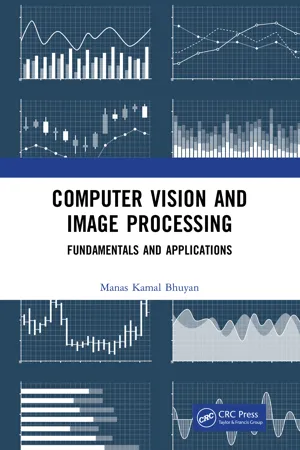
- 442 pages
- English
- ePUB (mobile friendly)
- Available on iOS & Android
eBook - ePub
About this book
The book familiarizes readers with fundamental concepts and issues related to computer vision and major approaches that address them. The focus of the book is on image acquisition and image formation models, radiometric models of image formation, image formation in the camera, image processing concepts, concept of feature extraction and feature selection for pattern classification/recognition, and advanced concepts like object classification, object tracking, image-based rendering, and image registration. Intended to be a companion to a typical teaching course on computer vision, the book takes a problem-solving approach.
Frequently asked questions
Yes, you can cancel anytime from the Subscription tab in your account settings on the Perlego website. Your subscription will stay active until the end of your current billing period. Learn how to cancel your subscription.
No, books cannot be downloaded as external files, such as PDFs, for use outside of Perlego. However, you can download books within the Perlego app for offline reading on mobile or tablet. Learn more here.
Perlego offers two plans: Essential and Complete
- Essential is ideal for learners and professionals who enjoy exploring a wide range of subjects. Access the Essential Library with 800,000+ trusted titles and best-sellers across business, personal growth, and the humanities. Includes unlimited reading time and Standard Read Aloud voice.
- Complete: Perfect for advanced learners and researchers needing full, unrestricted access. Unlock 1.4M+ books across hundreds of subjects, including academic and specialized titles. The Complete Plan also includes advanced features like Premium Read Aloud and Research Assistant.
We are an online textbook subscription service, where you can get access to an entire online library for less than the price of a single book per month. With over 1 million books across 1000+ topics, we’ve got you covered! Learn more here.
Look out for the read-aloud symbol on your next book to see if you can listen to it. The read-aloud tool reads text aloud for you, highlighting the text as it is being read. You can pause it, speed it up and slow it down. Learn more here.
Yes! You can use the Perlego app on both iOS or Android devices to read anytime, anywhere — even offline. Perfect for commutes or when you’re on the go.
Please note we cannot support devices running on iOS 13 and Android 7 or earlier. Learn more about using the app.
Please note we cannot support devices running on iOS 13 and Android 7 or earlier. Learn more about using the app.
Yes, you can access Computer Vision and Image Processing by Manas Kamal Bhuyan in PDF and/or ePUB format, as well as other popular books in Computer Science & Computer Graphics. We have over one million books available in our catalogue for you to explore.
Information
Part I
Image Formation and Image Processing
1
Introduction to Computer Vision and Basic Concepts of Image Formation
CONTENTS
1.1Introduction and Goals of Computer Vision
1.2Image Formation and Radiometry
1.2.1Image formation
1.2.2Radiometric quantities
1.2.3Shape from shading
1.2.4Photometric stereo
1.3Geometric Transformation
1.3.12D transformations
1.3.23D transformations
1.4Geometric Camera Models
1.4.1Single camera setup of image formation
1.4.2Image formation in a stereo vision setup
1.4.3Basics of stereo correspondence
1.4.4Issues related to accurate disparity map estimation
1.5Image Reconstruction from a Series of Projections
1.5.1Inverse Radon transform - back-projection method
1.5.2Inverse Radon transform - Fourier transform method
1.6Summary
1.1 Introduction and Goals of Computer Vision
Computer vision is a field of computer science, and it aims at enabling computers to process and identify images and videos in the same way that human vision does. Computer vision aims to mimic the human visual system. The objective is to build artificial systems which can extract information from images, i.e., objective is to make computers understand images and videos. The image data may be a video sequence, depth images, views from multiple cameras, or multi-dimensional data from image sensors. The main objective of computer vision is to describe a real world scene in one or more images and to identify and reconstruct its properties, such as colour characteristics, shape information, texture characteristics, scene illumination, etc.
Let us see the similarity between a human visual system and a computer vision system. As illustrated in Figure 1.1, the basic principle of these two systems is almost same, i.e., conversion of light into useful signals/information from which accurate models of the physical world are constructed. Similarly, when considered at a high level, the structures of human and computer vision are somewhat similar, i.e., both have light sensors which convert photons into a signal (image), a processing step, and finally a mechanism to interpret the signal (object recognition).

FIGURE 1.1 Human visual system vs. computer vision.
The difference between computer vision, image processing and computer graphics...
Table of contents
- Cover
- Half Title
- Title Page
- Copyright Page
- Dedication
- Contents
- Preface
- Author
- Part I: Image Formation and Image Processing
- Part II: Image Features
- Part III: Recognition
- Part IV: Applications
- Bibliography
- Index